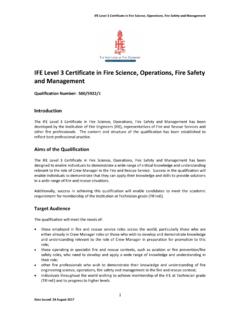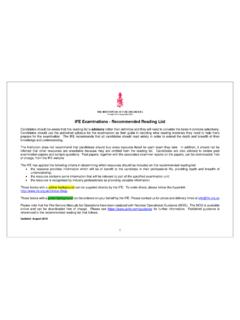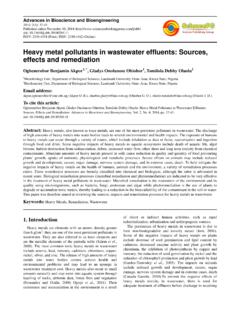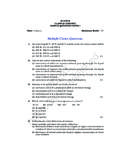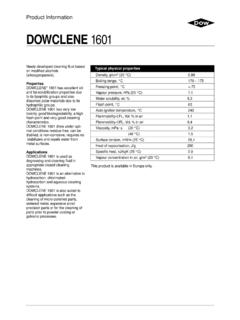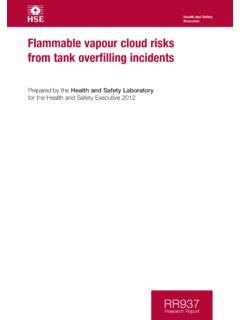Transcription of IFE Level 2 Certificate - 2018
1 IFE Level 2 Certificate in Fire Science, Operations and Safety 1 Date issued: 8 August 2018 IFE Level 2 Certificate in Fire Science, Operations and Safety Qualification Number: 500/5925/7 Introduction The IFE Level 2 Certificate in Fire Science, Operations and Safety has been developed by the Institution of Fire Engineers (IFE), representatives of Fire and Rescue Services and other fire professionals. The content and structure of the qualification has been established to reflect best professional practice and covers key knowledge and understanding in the areas of fire science, fire service operations and fire safety. Aims of the Qualification The IFE Level 2 Certificate in Fire Science, Operations and Fire Safety has been designed to enable individuals to demonstrate a wide range of critical knowledge and understanding relevant to the role of firefighter. Success in the qualification will enable individuals to demonstrate that they can apply their knowledge and skills to provide solutions to a range of fire and rescue activities.
2 Target Audience The qualification will meet the needs of: those employed, or preparing for employment, as firefighters who wish to develop and demonstrate their knowledge and understanding relevant to the role those operating in specialist contexts, such as aviation fire operations or fire safety inspection roles and who wish to demonstrate their knowledge and understanding relevant to the role other fire professionals who wish to demonstrate their knowledge and understanding of fire science, operations and fire safety IFE Level 2 Certificate in Fire Science, Operations and Safety 2 Date issued: 8 August 2018 Learning Outcomes Candidates who achieve this qualification should be able to: carry out mathematical calculations accurately and understand basic scientific principles in relation to fire and the methods of extinguishing fire understand basic firefighting and rescue procedures and know how to use equipment in firefighting operations understand the safety precautions and prevention methods used to protect individuals and the built environment Qualification Structure The qualification consists of one unit: Fire Science, Operations and Fire Safety (Ofqual Unit Reference number R/505/5748).
3 The unit is divided into three sections: Fire Engineering Science Fire and Rescue Operations Fire Safety Form of Assessment The assessment takes the form of one written three-hour examination. The examination contains 120 multiple choice questions. The examination is divided into three sections, reflecting the three sub-sections of the unit. The Fire Engineering Science and Fire and Rescue Operations sections of the paper each contain 45 questions and the Fire Safety section contains 30 questions. Examinations are designed to ensure that all sections of the syllabus are tested in each examination. Grading and Certification Successful candidates will be awarded a Pass. Outcomes are not graded. In order to achieve a Pass, candidates must achieve at least 50% of the marks available ie 60 correct responses. (Note: Grade boundaries are reviewed and confirmed following each examination session in line with best practice awarding procedures.) Candidates do not need to achieve a minimum number of marks in each of the sub-sections of the examination.
4 The total number of correct answers from across the whole paper is used to determine whether or not candidates have met the minimum requirement to achieve a Pass. IFE Level 2 Certificate in Fire Science, Operations and Safety 3 Date issued: 8 August 2018 Entry Requirements There are no formal entry requirements. However, candidates are advised that mathematical skills will be required in order to carry out and complete calculations in section 1 of the examination. Qualification Learning Time The length of time needed to prepare for this examination will vary depending upon the starting point for each individual. Research suggests that candidates should spend around 180 hours preparing for the examination. This equates to around 60 hours for each section of the syllabus although candidates may need to allocate a higher proportion of their preparation time to one of more of the sections depending upon their pre-existing knowledge and understanding.
5 Total qualification time is 183 hours. 180 hours of study. For most candidates, this will be self-study. However, it may also include some relevant training. 3 hours of assessment (directed time) ie one three-hour examination. Recommended Reading Candidates preparing for the examinations are advised to refer to the IFE s recommended reading list. This list can be found at: Progression Candidates who are successful in achieving the Level 2 Certificate will have developed the knowledge and understanding to enable them to undertake further study and progress to qualifications at Level 3, such as the IFE Level 3 Certificate and/or the IFE Level 3 Diploma. At Level 3, rather than achieving the full qualification, candidates may extend specific aspects of their knowledge and understanding by studying specific units eg Fire Safety. Further Information Further information on examination conditions is available in the IFE booklet, Rules and Information for Candidates Taking IFE Examinations.
6 This booklet can be downloaded from the IFE s website. IFE Level 2 Certificate in Fire Science, Operations and Safety 4 Date issued: 8 August 2018 Unit 1: Fire Science, Operations and Fire Safety Unit Reference Number: R/505/5748 Section 1: Fire Engineering Science 1. Mathematics Assessment Objective Knowledge, Understanding and Skills Apply an understanding of mathematics to solve problems The four basic processes - addition, subtraction, multiplication and division Processes in respect of fractions, decimals, percentages, ratios and proportions Demonstrate an understanding of basic geometry Two- dimensional shapes square, rectangle, quadrilateral, parallelogram, rhombus, trapezium, triangle, circle Three-dimensional objects cube, cuboid, pyramid, prism, cylinder, cone, sphere Undertake calculations in respect of various geometrical shapes and objects Area and perimeter of regular and irregular shapes Volume and capacity of rectangular and circular tanks Volume and capacity of hose and pipelines 2.
7 Physical Properties of Matter Assessment Objective Knowledge, Understanding and Skills Define and understand the basic physical properties of matter Matter Mass Density Relative density (specific gravity) Vapour density Liquids of different density Gases of different density Matter and energy Melting, boiling and evaporation 3. Mechanics Assessment Objective Knowledge, Understanding and Skills Define and understand basic terms and undertake calculations involving physical mechanics Motion, including gravity, speed, velocity and acceleration Momentum and Force Work, Energy (including Potential Energy and Kinetic Energy) and Power Friction Simple machines ie levers, mechanical advantage IFE Level 2 Certificate in Fire Science, Operations and Safety 5 Date issued: 8 August 2018 4. Heat and Temperature Assessment Objective Knowledge, Understanding and Skills Understand that heat is a form of energy and demonstrate an understanding of how temperature can be measured Measuring temperature Thermometric scales: o Celsius or Centigrade o Fahrenheit o Kelvin or Absolute Other methods of measuring temperature: o Air or gas thermometer o Using solids o Thermocouples o Thermistors o Comparison by brightness o Infrared Define and use units of heat Joule Calorie The British thermal unit Define and understand the terms used in the context of heat transfer Specific heat Changes of state and latent heat: o Latent heat of vapourisation o Effect of change of pressure on boiling point and latent heat o Latent heat of fusion o Cooling by evaporation Demonstrate an understanding of thermal expansion and the liquefaction of gases and their practical applications The thermal expansion of solids.
8 O Coefficient of linear expansion o Nickel-iron alloy (Invar) o Expansion in large metal structures o Thermostats (Bi-metallic strips) o Coefficients of superficial and cubical expansion of solids The thermal expansion of liquids: o Cubical expansion o The effect of expansion on density The expansion of gases: o Temperature, pressure and volume o The liquefaction of gases: o Critical temperature and pressure o Liquefied gases in cylinders Define and understand the gas laws Boyle s Law Charles s Law Law of Pressures The General Gas Law Understand the processes of heat transmission Conduction Convection Radiation IFE Level 2 Certificate in Fire Science, Operations and Safety 6 Date issued: 8 August 2018 5. Chemistry and Combustion Assessment Objective Knowledge, Understanding and Skills Define basic chemical terms and describe their structures o Atoms (protons, neutrons and electrons) Molecules Elements Compounds Mixture Radicals Atomic mass Molecular mass Valency Reactivity Understand basic chemical formulae and equations The use of symbols to write formulae Nomenclature Interpret simple formulae and equations Understand the basic chemistry of combustion The components of the fire tetrahedron Heat of reaction and calorific value Types of flames and practical examples: o Premixed o Diffusion Laminar and turbulent flow Flashpoint Fire point Sustained fires Ignition.
9 O Spontaneous ignition temperature o Self-heating and spontaneous combustion o Smouldering Understand the main factors involved in the extinction of fire Starvation Smothering Cooling Explain how the main fire extinguishing media extinguish fire Water Foam Vaporising liquids Carbon dioxide and inert gases Dry chemical powders Blanketing Beating out IFE Level 2 Certificate in Fire Science, Operations and Safety 7 Date issued: 8 August 2018 6. Electricity Assessment Objective Knowledge, Understanding and Skills Define and understand basic electrical units and their symbols Amperes Volts (Electromotive Force - EMF) Ohms Joules Watts Define, understand and use Ohm s Law Principles of Ohm s Law Undertake Ohm s Law calculations Describe the types of electrical supply and current flow in a circuit Alternating current (ac) and direct current (dc) Simple circuitry The resistance of a circuit Understand the purpose and significance of conductors and insulators Examples of good and bad conductors Examples of insulators for different purposes Understand the purpose of providing protective devices to electrical circuits Understand how a short circuit occurs Earthing Fuses Circuit breakers Demonstrate an understanding of electrical hazards and safeguards Electrical causes of fire Prevention of electrical causes of fire 7.
10 Hydraulics Assessment Objective Knowledge, Understanding and Skills Understand the properties of water and basic principles of hydraulics Properties of water Principal characteristics of pressure Relationship between pressure and head Loss of pressure due to friction Energy changes in water streams Water power and efficiency Jet reaction Water hammer Understand how pressure is measured with instruments Water gauges (manometers) Pressure and compound gauges Understand the influence of atmospheric pressure on suction lift Atmospheric pressure Suction lift Siphons IFE Level 2 Certificate in Fire Science, Operations and Safety 8 Date issued: 8 August 2018 Section 2: Fire and Rescue Operations 1. Incident Command Assessment Objective Knowledge, Understanding and Skills and explain the key principles of Incident Command Roles and responsibilities: o Command o Communications o Situational awareness o Shared understanding and expectations Structuring an incident: o Span of control o Sectorisation o Cordons Risk assessments at an incident: o The Firefighter Safety Maxim o Risk concepts (Hazard and Risk) o Dynamic risk assessment o Analytical assessment o Personal or individual assessment Risk reduction: o Eliminate the risk o Reduce the risk o Isolate the risk o Control the risk o Personal Protective Equipment (PPE) o Safety Officers Tactical control: o Offensive o Defensive o No overall mode o Emergency evacuation and tactical withdrawal o Firefighter emergency Investigations Closure and handover Debriefing 2.
